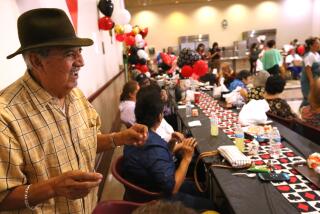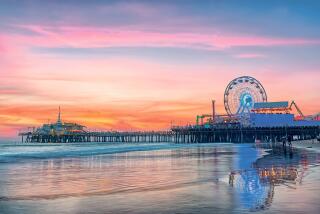L.A. climbs past 4 million
Finally, something to explain the gridlock at your local coffeehouse and clogged freeways that seem to extend well into the night.
The population of L.A. quietly surpassed the 4-million mark for the first time last year, the California Department of Finance announced Tuesday.
Angelenos probably don’t need a demographer to tell them what they already know: that the city is growing more densely populated. But the numbers show that the city gained 37,658 residents last year, and as of Jan. 1, its population was 4,018,080.
“It’s a spectacular arc of development when you consider that in 1900, L.A. had a population of 102,459,” said historian Kevin Starr.
L.A. lore holds that the city was founded in 1781 by 44 people, transplants from the San Gabriel Mission. That puts the 226-year gain in population at 4,018,036.
The L.A. numbers were part of a report released Tuesday that pegged the state’s population at almost 37.7 million. That represents a growth of almost 1.3%, or 470,000, in 2006.
State demographers use a variety of data -- including driver’s licenses, school enrollments, Medi-Cal recipients, birthrates, immigration and state to state migration -- to estimate population change.
The Riverside County city of Beaumont saw the state’s fastest growth rate, 21.2%.
In Orange County, Irvine passed 200,000 in population, bringing to 20 the number of cities in the state that exceed 200,000 in population.
But it was the Los Angeles numbers that had most people talking Tuesday.
Just how big does that make L.A.?
With 4 million people, the city of Los Angeles has more people than 24 states, according to federal census data. And it’s got roughly the same number as the entire country of New Zealand.
The increase occurred over the last year, as L.A. added 10,239 housing units, according to the state data.
Many of those units were downtown, where the city has seen a marked increase in population as former commercial buildings have been converted into lofts and apartments and a number of new residential buildings have opened.
The city, Starr said, is “embracing and exulting in its urbanism.”
Starr and other historians have said that Los Angeles’ role as an international city, attracting immigrants from all over the world, has been a key factor in its quick demographic rise.
Los Angeles, said Harry Pachon, a USC public policy professor, has “been in a growth mode.... The dynamism of Los Angeles continues to attract people.”
Pachon sees modest growth in the foreseeable future. Families in Latin America are having fewer children, he said, diminishing population pressures there. He also said that the continued increase in housing prices in Southern California meant that more people were seeking economic opportunity outside the region.
L.A. threw itself parties (and the L.A. Times produced banner headlines) when the city reached the 1-million and 1.5-million levels, in 1923 and 1940. (The 1-million mark was estimated by counting the number of, among other things, barber shops.)
But don’t expect a lot of celebrating of the new milestone.
Edward Soja, a professor of urban planning at UCLA, called passing the 4-million mark “not that dramatic a transition,” especially as L.A.’s population gains are eclipsed, in percentage, by growth elsewhere in the region.
But he said that he worried that Southern California in general is ill-equipped to deal with rapid growth, especially the area’s administrative and governmental structures.
“I would say never before is it more needed to have some form of regional coordination, whether we are talking about housing and homelessness or transportation and airports or environment and pollution,” Soja said.
The L.A. region, he added, “has the worst housing crisis anywhere in the developed world. It’s not being addressed with the urgency it needs to be addressed.”
Janelle Erickson, a spokeswoman for Mayor Antonio Villaraigosa, wasn’t weighing in about whether the numbers were a good or bad thing. But she did hint that she understood why people were moving to the city.
“What the mayor always says is that Los Angeles is a city where the world comes together,” Erickson said. “Los Angeles is a city of America’s hope and promise, where the dreams of so many have come to life.”
Except, perhaps, on the 405 Freeway at rush hour. Or the Starbucks line at 8:30 a.m.
*
(BEGIN TEXT OF INFOBOX)
How big is L.A.?
37,658
Number of new residents in 2006
10,239
Number of new housing units in ’06
4,018,080
Total population
Source: State Department of Finance
More to Read
Sign up for Essential California
The most important California stories and recommendations in your inbox every morning.
You may occasionally receive promotional content from the Los Angeles Times.










